Why The Wicker Man has divided opinion for 50 years
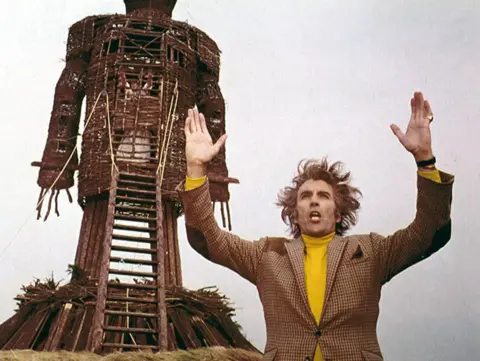 Alamy
AlamyLike all the best cult films, The Wicker Man has been dividing audiences from the moment it slipped into Britain's cinemas 50 years ago.
The story of a Christian police officer sent to a remote Scottish island community to investigate the disappearance of a local girl has been described as "the Citizen Kane of horror movies" - and derided as one of the 10 worst films ever made.
The project started off well.
It was written by Anthony Shaffer, hot off the hit play and film Sleuth, and its big horror star Christopher Lee said it was one of the finest screenplays he had ever read.
But things started to go wrong when it went into production. The budget was too low, its island setting had to be recreated on the mainland in Galloway, and a story centred on the importance of spring and pagan May festivals had to be shot in October.
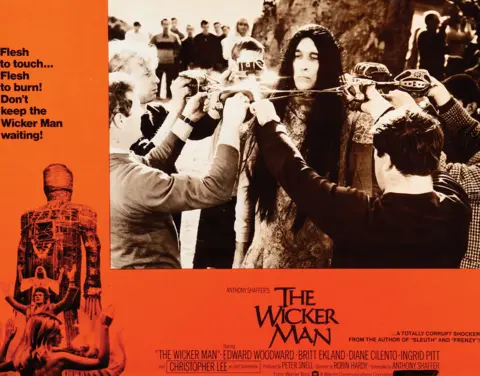 Getty Images
Getty ImagesA further row over editing and a lacklustre release as a B-movie alongside Don't Look Now in 1973 almost smothered the film before it was born.
"In contemporary terms, that would be like a Steven Spielberg film going straight to video, virtually unthinkable," wrote Edward Woodward, who played the police officer, in the foreword to Allan Brown's book Inside The Wicker Man.
But just as the film deals with the rebirth of nature every spring, The Wicker Man did not die.
It was reborn in small second-run cinemas, on TV, on video and DVD, and over the years its reputation grew.
Academics and a growing fan base pored over its themes and strange quirks. After all, how many films deal with paganism, Christianity, murder and rural isolation with a cast including Scottish comedy greats, screen horror icons, two international sex symbols - plus songs and dances?
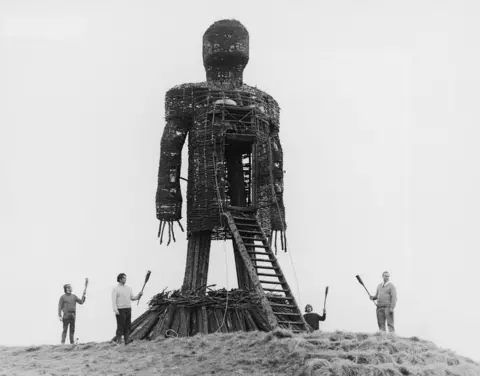 Getty Images
Getty ImagesChristopher Lee, despite his star status, made the film for nothing and championed it for his entire life.
"It's one of the most remarkable films ever made," he said in a 1998 BBC documentary.
"It's not only amusing, it's romantic, erotic, very disturbing and very frightening."
A "premiere" of the film took place in Newton Stewart in January 1974 as a thank you to local people who had supported the production.
This week the cinema hosted another premiere: the restored 4K version of The Wicker Man, ahead of a new UK-wide release for the film.
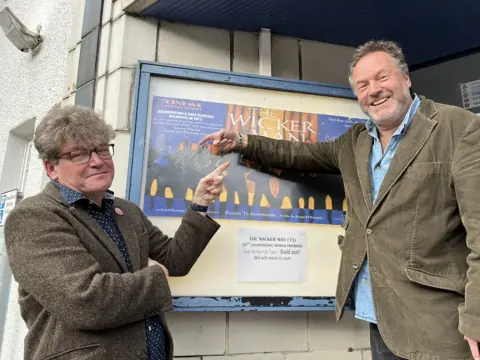
The director Robin Hardy, who died in 2016, had a complicated private life. He had five wives and eight children, two of whom spoke at last weekend's showing.
Justin Hardy, now a filmmaker himself, and his half-brother Dominic said it had taken them a long time to see the film objectively.
"I was nine at the time and I only ever saw that film as a bad pagan omen," said Justin. "That was when I lost my father and my home."
"I was distanced from it for a long time," added Dominic, a university professor who grew up in Canada. "It felt like a real gut punch."
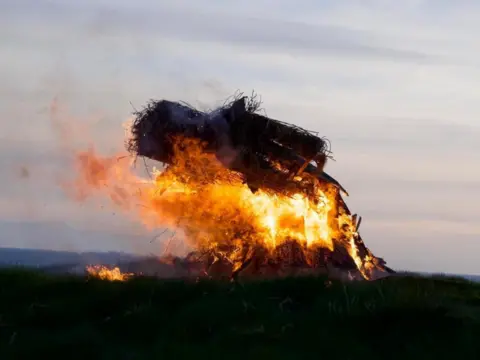
But the anniversary of The Wicker Man has brought them closer together and they are now making a film about their father's filmmaking legacy.
Despite decades of inspiring other films, documentaries, books and theses, material about their dad and the making of the film is still coming to light.
"A lady phoned us up to tell us she had six sacks of letters," said Justin.
"She said: 'Should I burn them?'"
The letters have been saved from the flames, unlike The Wicker Man of the film.
And to celebrate the anniversary, as well as the traditional pagan May Day festival, a new Wicker Man was burned this week.
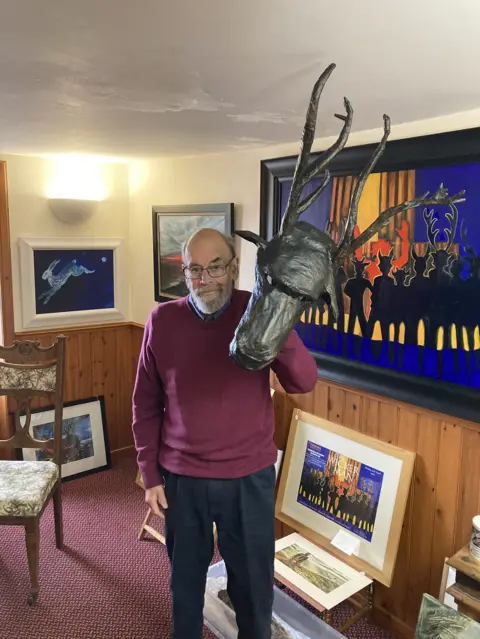
Created by artist Amanda Sunderland, it stood 15ft (5m) tall - a quarter of the one featured in the film - and met its end on the same site at Burrowhead, near Isle of Whithorn.
"My dad and two uncles were all extras in the film so I've always had a fascination," she said.
"We always asked to see the film when we were younger, and then more and more people were coming to the area asking about the film and no-one seemed to want to talk to them about it. So I thought: 'I can do that'."
Her father Ian Sunderland, who appears masked and dancing as an "antler man" in the film, has fond memories of making the film.
He and his brothers answered an advert and were surprised to be cast as masked villagers who took part in a procession behind Lord Summerisle as the film reaches its fiery climax.
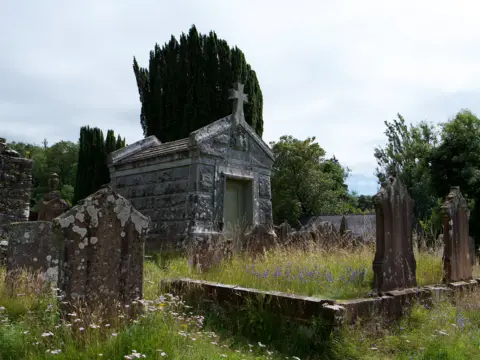 Julie Izon-Williams
Julie Izon-Williams"They brought a choreographer in on the first day and he wanted us to do dance steps in the procession," he recalled.
"If you look at us, you'll realise we were never going to be dancers so he had us sway to the music instead."
Lesley Mackie was just out of drama college when she was cast in the film as Daisy Pringle.
"I had three lines and I was definitely the oldest 'child' in that cast," she said.
"Then we went to the pub, and they discovered I could sing and that's why I ended up recording two songs in the film - The Highland Widow's Lament and Willow's Song. That's the one which Britt does her sexy dance to."
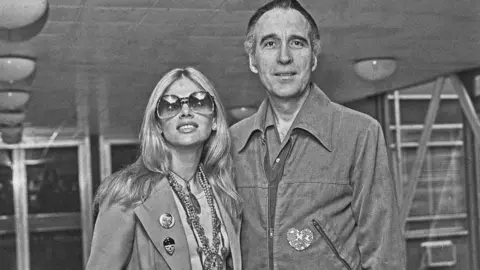 Getty Images
Getty ImagesIn 1973, Britt Ekland was an international sex symbol, and her naked dance in The Wicker Man may have contributed to its appeal.
But the scene gives us one of the film's most enduring controversies because it's not just Britt up there on the screen.
A body double was used and several women claim to have been contracted - but whose bottom made the final cut? It's still being debated.
Despite working on her Scottish accent with Lesley Mackie, Britt Ekland's speaking voice was dubbed by the Scottish actress and singer Annie Ross and the use of all these doubles may explain why she later claimed never to have seen the film.
For fans of the film, all this just adds to its appeal.
Irish IT specialist Fergal O'Riordan launched a crowdfunding appeal to make a documentary around the 50th anniversary.
In the spirit of the original, he's calling on friends, family and the local community to support production.
"There are so many layers to this movie," he said.
"There's a certain creativity to chaos and this movie had so much chaos. It wasn't fully organised, it wasn't fully budgeted, it just happened and I hope I can reflect that in my own slightly chaotic little movie."

He encouraged fans to come to the area for the anniversary, in costume, and a number answered the call.
Gavin and Lisa Eagleton-Muir spent their first wedding anniversary touring locations from the film.
Five years later, they're back in Dumfries and Galloway to meet other Wicker fans and celebrate the 50th anniversary of the film.
"It's unlike anything else you'll ever see," said Gavin.
"It's horror, but it isn't. It's a musical, but it isn't. It's an anomaly of a film but that's what makes it special."
The 4K restoration of the Final Cut of the Wicker Man will be released in cinemas on 21 June.
